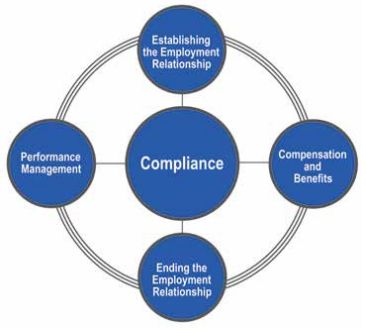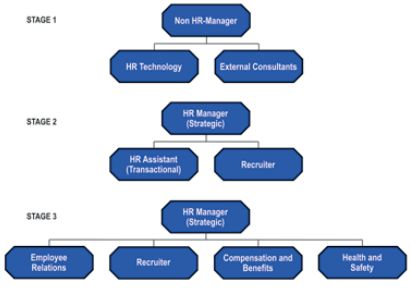Foreign investors confront a number of challenges when operating in the US. At the core of a successful business entity is its employees and it is essential that the Board of Directors establish a human resource function to manage all of the employment needs of the US subsidiary. The human resources function is both strategic and transactional, with human resource professionals having overlapping responsibilities. Compliance with the laws of the US, individual states and local municipalities is central to the HR function.

Fig. 1: The Human Resource Functions
Strategic Functions
The company must set its financial goals, as well as create and maintain the company's operating principles, such as accountability, collaboration, communication, customer focus, or innovation. Strategic responsibilities of the human resource professional include:
- assist in finding the best location(s) for the company's operations to attract the best talent;
- create staffing plan and budget in line with the company's overall budget and financial goals;
- recruit the best talent;
- develop pay structures and salary ranges;
- establish and document the most appropriate employment relationships;
- design and implement compensation system and benefit and wellness programs;
- design and implement a performance management system; and
- create lawful procedures for ending employment relationships.
Transactional Functions
The company must comply with the regulations of federal, state and local governments, including the collection and submission of Social Security and payroll taxes, as well as taxes for workers' and unemployment compensation. The human resource professional is responsible for various day-to-day transactional responsibilities, which include:
- draft and implement work rules and policies and procedures to be incorporated in the employee handbook;
- draft job descriptions for the employees;
- process payroll accurately and timely;
- administer benefit programs such as medical insurance, retirement savings plans, and policies for leaves of absence;
- provide a healthy and safe working environment;
- assist supervisors with addressing employee performance issues;
- train employees to safely and effectively perform their duties and responsibilities;
- administer performance management system to evaluate the effectiveness of the employees; and
- implement procedures to respond meaningfully and lawfully to employees' issues and complaints to avoid interference with the company's operations.

Fig. 2: The Human Resource Circle of Responsibilities
To effectively manage the company's human resource department, HR professionals utilize technology and software, conduct research, seek input and education opportunities from professional HR associations, in addition to relying on the expertise of consultants and attorneys.
The Human Resource Department
The size and staffing of the human resource department depends upon a number of factors, such as the number of employees, whether the company has multiple locations, and the company's plans for expansion. At the earliest stage, the human resource function may be managed by the company's finance or administration manager, relying on software and the advice and counsel of external consultants and attorneys. As the company expands to about 50 employees, a dedicated human resource professional is typically hired in the role of HR generalist, coordinator or manager.
Successful companies consider the human resource professional an important member of the executive management team, responsible for communicating and implementing the company's goals and serving as a liaison between employees and management. This professional may hire and supervise a recruiter, as well as an HR assistant to perform payroll, handle benefits administration and other transactional tasks.
With additional expansion up to 150 employees, specialists are needed to help plan strategies and to oversee compensation and benefits, employee relations, and workplace health and safety.

Fig. 3: Stages of the HR Department
When deciding to recruit and hire a human resource professional, the company should consider the candidate's experience with new and growing companies, including adjusting to changes in a company's operations, as well as his/her ability to handle multiple challenges and projects. These attributes are as important as the candidate's education, years of experience and professional certifications.
Conclusion
With the appropriate infrastructure and legal advice, foreign investors can successfully expand their operations into the United States. Please contact us for more information.
Previously Published by German American Chambers of Commerce
The content of this article is intended to provide a general guide to the subject matter. Specialist advice should be sought about your specific circumstances.

